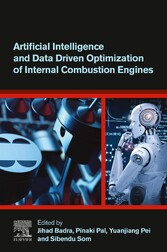Suche
Lesesoftware
Info / Kontakt

Artificial Intelligence and Data Driven Optimization of Internal Combustion Engines
von: Jihad Badra, Pinaki Pal, Yuanjiang Pei, Sibendu Som
Elsevier Reference Monographs, 2022
ISBN: 9780323884587 , 262 Seiten
Format: ePUB, PDF, Online Lesen
Kopierschutz: DRM





Preis: 175,00 EUR
eBook anfordern 
Front Cover
1
ARTIFICIAL INTELLIGENCE AND DATA DRIVEN OPTIMIZATION OF INTERNAL COMBUSTION ENGINES
2
ARTIFICIAL INTELLIGENCE AND DATA DRIVEN OPTIMIZATION OF INTERNAL COMBUSTION ENGINES
4
Copyright
5
Contents
6
Contributors
10
Foreword
12
Preface
16
1 - Introduction
18
1. Industrial revolution
18
2. Artificial intelligence, machine learning, and deep learning
19
3. Machine learning algorithms
20
4. Artificial intelligence-based fuel-engine co-optimization
21
4.1 Optimization of internal combustion engine
21
4.1.1 Design of experiments
22
4.1.2 Genetic algorithm
24
4.1.3 Machine learning-based algorithms
25
4.2 Optimization of fuel formulation
30
4.3 Mitigation of rare combustion events
32
5. Summary
33
References
33
1 - Artificial Intelligence to optimize fuel formulation
42
2 - Optimization of fuel formulation using adaptive learning and artificial intelligence
44
1. Introduction and motivation
44
2. Mixed-mode combustion and fuel performance metrics
45
3. A neural network model to predict fuel research octane numbers
48
4. Optimization problem formulation and description of solution approaches
49
4.1 Constrained optimization formulation
49
4.2 Genetic algorithm
50
4.3 Gaussian process–based surrogate model optimization algorithm
52
5. Numerical experiments and results
54
6. Discussion
57
7. Summary and concluding remarks
59
Acknowledgments
60
References
60
3 - Artificial intelligence–enabled fuel design
64
1. Transportation fuels
64
1.1 Fuel representation
64
1.2 Fuel formulation workflow
65
1.3 Artificial intelligence modeling approaches
66
2. Application of artificial intelligence to fuel formulation
69
2.1 High throughput screening: finding a needle in the haystack
69
2.2 Fuel property prediction by machine learning models
71
2.3 Reaction discovery
74
2.4 Fuel-engine co-optimization
75
3. Conclusions and perspectives
75
Acknowledgments
77
References
77
2 - Artificial Intelligence and computational fluid dynamics to optimize internal combustion engines
86
4 - Engine optimization using computational fluid dynamics and genetic algorithms
88
1. Introduction
88
2. Modeling framework and acceleration strategies
91
2.1 Computational fluid dynamics acceleration techniques
91
2.1.1 Adaptive mesh refinement
91
2.1.2 Detailed chemistry acceleration strategies
92
2.2 Engine geometry generation
93
2.2.1 Method of splines
93
2.2.2 Method of forces
94
2.3 Virtual injection model
95
3. Optimization methods
96
3.1 Fundamentals of genetic algorithms
96
3.2 Pioneering investigations
98
3.3 Multiobjective framework
101
3.4 Convergence acceleration
108
4. Summary and concluding remarks
114
References
115
5 - Computational fluid dynamics–guided engine combustion system design optimization using design of experiments
120
1. Introduction
120
2. Methodologies
123
2.1 Design space construction
124
2.2 Response surface model formulation
126
2.3 Model-based design optimization and verification
129
3. A recent application
130
3.1 Engine and fuel specifications
130
3.2 Computational fluid dynamic model setup and validation
130
3.3 Design variables
131
3.4 Objective variables and evaluation method
133
3.5 Data fitting and optimization
134
4. Recommendations for best practice
135
4.1 Adequate computational fluid dynamic model validation
135
4.2 Efficient geometry and mesh manipulation
136
4.3 Sample size
136
4.4 Optimization across full engine operation range
136
4.5 Computational efficiency
136
5. Conclusions and perspectives
137
Acknowledgments
138
References
138
6 - A machine learning-genetic algorithm approach for rapid optimization of internal combustion engines
142
1. Introduction
142
2. Engine optimization problem setup
144
3. Training and data examination
146
4. Machine learning-genetic algorithm approach
149
4.1 Optimization methodology
149
4.2 Repeatability of machine learning-genetic algorithm
151
4.2.1 Extension of variable domain
153
4.3 Postprocessing and robustness
156
5. Automated machine learning-genetic algorithm
158
5.1 Hyperparameter selection
159
5.1.1 Manual selection
159
5.1.2 Automated strategies for selecting hyperparameters
160
5.2 Problem setup
162
5.3 Results
163
6. Summary
173
Acknowledgments
173
References
173
7 - Machine learning–driven sequential optimization using dynamic exploration and exploitation
176
1. Introduction
176
2. Active ML optimization (ActivO)
177
2.1 Basic algorithm
177
2.2 Query strategies
178
2.3 Convergence criteria
180
2.4 Dynamic exploration and exploitation
181
3. Case study 1: two-dimensional cosine mixture function
182
4. Case study 2: computational fluid dynamics (CFD)-based engine optimization
188
5. Conclusions
196
Acknowledgments
197
References
197
3 - Artificial Intelligence to predict abnormal engine phenomena
200
8 - Artificial-intelligence-based prediction and control of combustion instabilities in spark-ignition engines
202
1. Introduction
202
1.1 Artificial intelligence applications to engine controls
202
1.2 Dilute combustion instability background
204
2. Case study: artificial-intelligence-enhanced modeling of dilute spark-ignition cycle-to-cycle variability
206
3. Case study: neural networks for combustion stability control
210
3.1 Artificial neural networks
210
3.2 Spiking neural networks
212
4. Case study: learning reference governor for model-free dilute limit identification and avoidance
216
4.1 Constrained combustion phasing control problem
216
4.2 Learning reference governor for avoiding misfire events
219
5. Summary
221
References
222
9 - Using deep learning to diagnose preignition in turbocharged spark-ignited engines
230
1. Introduction
230
1.1 Fault detection
230
1.2 Optimization and control
231
1.3 Predicting combustion parameters (phasing and cycle-to-cycle variation) and emissions
232
2. Preignition detection using machine learning algorithm
232
2.1 Feed forward multilayer neural networks
234
2.2 Convolutional neural networks
235
2.3 Recurrent neural networks
236
3. Activation functions
238
4. Experiments and data extraction
239
5. Machine learning methodology
241
6. Model 1: Input from principal component analysis
247
7. Model 2: Time series input
248
8. Model metrics
249
9. Results and discussion
250
9.1 Training and validation losses
250
10. Conclusions
251
References
252
Further reading
253
Index
256
A
256
B
257
C
257
D
257
E
258
F
258
G
258
H
258
I
258
K
259
L
259
M
259
N
259
O
260
P
260
Q
260
R
260
S
260
T
260
U
260
V
260
Z
260
Back Cover
262




